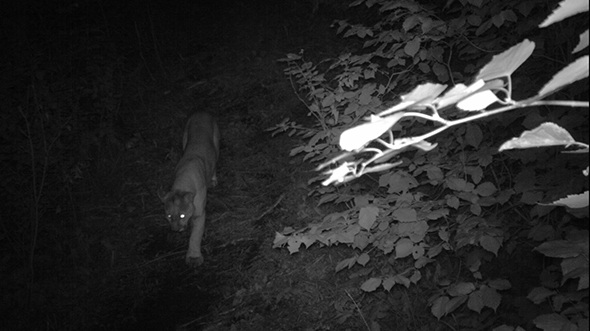Cougar Safety
Riding Mountain National Park
Four interesting facts about cougars in Riding Mountain National Park

1. There is no official cougar population within the park as defined by biology.
Hey, don't worry, we're not saying that there aren't cougars in the park! What we mean is that there is no evidence that cougars are reproducing and having young. In the recent past, 2 cougars were killed outside the park boundary. Both of these animals were young, and had not likely bred (see #2 below). However, given the increase in the number of sightings within the park and region, it is likely only a matter of time before we have sightings of kittens.
2. Genetic research indicates that these cougars likely arrived on foot from North Dakota.
The southwestern section of the state of North Dakota has a relatively large cougar population, and young animals from this population must leave the region in order to find new territories of their own. Thus, most, if not all, of the cougars observed here are just passing through the area as they search for good hunting grounds.
3. Certain areas of the park offer better cougar habitat than others.
Cougars prefer to hunt relatively small game, with the largest regular prey being deer. Thus, while RMNP has a relatively large deer population, it is spread out across the entire park. Cougars will be attracted to areas where deer congregate in large numbers, and thus are attracted to Manitoba's southern river valleys such as the Assiniboine River. The escarpment of RMNP, though, may offer good habitat, and the relatively large deer population in Wasagaming and Onanole may prove attractive to a cougar in the future.
4. The risk associated with people being hurt by cougars is extremely low.
With only one or two cougars in the park, there is an extremely low chance of even seeing a cougar - most of the recent records of cougars have been recorded through the use of trail cameras. If visitors are concerned about their safety, they should follow the same rules that we advise regarding bears - travel in groups of three or more, keep your dog on a leash, and make noise as you travel the trails. These precautions should be more than adequate to ensure a safe visit.
Cougar Safety
While cougars are a natural predator in the park, they can present a potential risk to people and pets. Visitors and residents should be aware and it is important to take precautions as there has been sighting of cougars in the park.
Please Take the Following Precautions
- Supervise children playing outdoors and don’t let children play near dense vegetation. Do not leave small children unattended.
- If you want to venture into the woods, we recommend you travel in groups of three or more and go during daylight hours only.
- Remember, cougars are solitary animals and are most active at dusk and dawn.
- Free-roaming pets may attract and be attacked by cougars. Keep your dog on a leash at all times. Walk your pets during the day and avoid wooded areas. Bring your pets inside at night.
- Don’t leave out any animal attractants such as pet food and garbage. Always use the wildlife-proof garbage bins.
- Talk to your children about what to do to if they encounter a cougar.
If You See a Cougar
- Do not approach the animal.
- Face the cougar, and retreat slowly – do NOT run or play dead.
- Try to appear bigger by holding your arms or an object above your head.
- Immediately pick up small children.
- Be aggressive. Shout, wave a stick or throw rocks to deter an attack.
If you see a cougar or fresh signs of any carnivore activity, please leave the area immediately and call the Park Dispatch at 1-877-852-3100.
- Date modified :